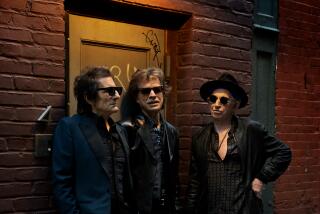Link Wray, 76; Rebel Guitarist’s Power Chord in ‘Rumble’ Started Rock Music on Its Journey to Punk and Heavy Metal
- Share via
Link Wray, the rock guitar pioneer who gave birth to the aggressively primal sound known as the power chord on his 1958 instrumental hit “Rumble” and influenced two generations of rock guitarists, has died. He was 76.
Wray died Nov. 5 at his home in Copenhagen, his family said on his website. Although no cause of death was given, his wife, Olive, and son, Oliver, wrote that the North Carolina native’s heart had been “getting tired.”
On stage, the rebel Wray never tired of wielding his ax.
“He just loved playing,” said Michael Molenda, editor in chief of Guitar Player magazine, who saw Wray perform last July at Slim’s, a small San Francisco club.
“He was certainly a young soul, very gracious, kind of like a punk to the end,” Molenda said Monday. “He wasn’t like a guy who was 76 years old. He was like a 19-year-old in a 76-year-old body.”
Robert Hilburn, The Times’ pop music critic, said Monday that Wray “was one of the key figures who helped establish the guitar as the instrument of choice in rock.”
Wray, Hilburn said, “was someone who turned the sensualness and mystery of the blues into a supercharged sound that was both eerie and anxious. His key works were powered by a force and, even at times, a brutalness that encouraged generations of musicians to explore the extreme boundaries of human emotion and sonic possibility.”
The legendary three-chord riff that Wray used in “Rumble,” his signature tune and biggest seller, has reverberated down through the decades.
“Without the power chord, punk rock and heavy metal would not exist,” Dan Del Fiorentino, historian for the Museum of Making Music in Carlsbad, said Monday.
Countless musicians, including Jimmy Page of Led Zeppelin, Bruce Springsteen and Jeff Beck, are said to have been influenced by Wray.
“He is the king; if it hadn’t been for Link Wray and ‘Rumble,’ I would have never picked up a guitar,” Pete Townshend of the Who wrote for one of Wray’s albums.
Neil Young once said, “If I could go back in time and see any band, it would be Link Wray and the Wraymen.”
Del Fiorentino said the raunchy sound of Wray’s guitar in “Rumble” represented a different attitude in rock music.
“It added more of a zing, more of a delinquency, if you will, to rock ‘n’ roll,” he said.
And Wray, the 1950s performer, personified his sound on stage.
“Who else in rock ‘n’ roll had a leather jacket and was smoking cigarettes, with sunglasses on in the middle of the night?
“That was him,” Del Fiorentino said.
Citing the impact of “Rumble,” Molenda wondered what it must have been like “to hear that big, distorted, evil ferocious chord for the first time.”
“Fifties rock was pretty clean, and you’ve got this guy -- he’s got a leather jacket, he looks scary -- and all of a sudden he plays this loud chord that practically tears your eyebrows off your face,” said Molenda. “It was extremely sexy and aggressive, and it kind of paved the way for the next level of rock ‘n’ roll.”
Wray’s legendary sound originated at a record hop hosted by a local DJ in Fredericksburg, Va.
In an interview with Guitar Player in June, Wray said that when the kids at the hop asked him to play a “stroll,” a popular, slow line dance, “I just made up something on the spot, because I didn’t know any stroll tune.”
And because there was no vocal on the song, Wray’s brother Vernon thought they should spotlight the guitar.
“So he took the vocal [mike] and put it in front of my amp, which just distorted the heck out of the small P.A. speakers,” recalled Wray.
The young crowd went wild for the sound. But reproducing the grungy tone in the recording studio for what became “Rumble” was another matter.
“When I tried to remember the sound that made those kids scream, I missed the distortion right away,” said Wray. “The sound was too clean -- at the gig the amps were jumping up and down, burning up with sound.”
To re-create the sound, Wray finally took a pencil and punched holes in his tiny Premier amp’s two 10-inch speakers.
Wray’s new sound didn’t impress Cadence Records owner Archie Bleyer, who was ready to pass on the song.
But his teenage daughter borrowed the recording for a birthday party. She loved it, excitedly telling her father that it reminded her of the rumble in “West Side Story.”
Renamed “Rumble,” the instrumental reached No. 16 on the national charts and sold more than a million copies -- after being attacked for promoting teen gang warfare and being banned from the airwaves in Boston and elsewhere. But, as Wray later said, that “just made it sell more.”
Half Shawnee Indian, Wray was born in Dunn, N.C., in 1929. When he was 8, a traveling guitarist named Hambone introduced him to the blues, giving him lessons on his front porch.
He began performing in the late ‘40s, joining his two brothers in a country and western band.
He served four years in the Army, and during the Korean War contracted tuberculosis, which later required the removal of one of his lungs and diminished his vocal capacity.
Wray followed the success of “Rumble” with “Rawhide” (1959) and “Jack the Ripper” (1963). Among his other songs are “Black Widow,” “Big City After Dark,” “Run Chicken Run” and “Switchblade.” In recent years, his music has been featured in movies, including “Pulp Fiction,” “Independence Day” and “Desperado.”
Wray moved to Denmark in 1978, living in a house on an island where Hans Christian Andersen once lived.
More to Read
The biggest entertainment stories
Get our big stories about Hollywood, film, television, music, arts, culture and more right in your inbox as soon as they publish.
You may occasionally receive promotional content from the Los Angeles Times.










